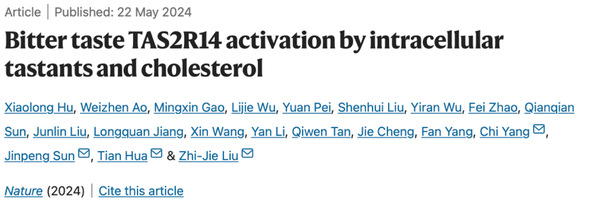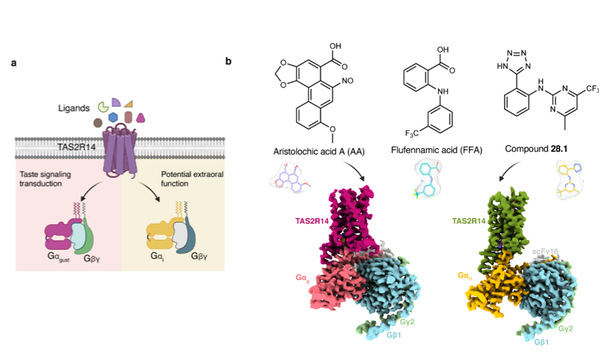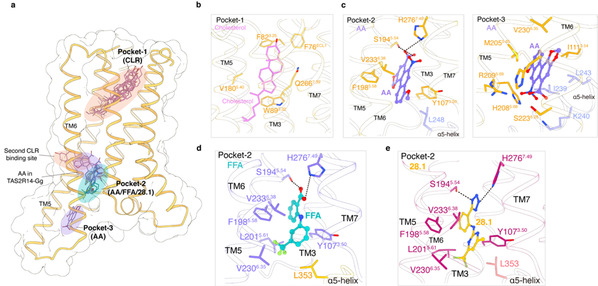Recently, a team led by Professor Liu Zhi-Jie, Director of the iHuman Institute, and Assistant Professor Hua Tian at the School of Life Science and Technology (SLST), in collaboration with the teams from Shandong University, and Shanghai Ninth People’s Hospital affiliated to Shanghai Jiao Tong University School of Medicine, unveiled the complex interactions between bitter taste receptors and intracellular tastants, including cholesterol. The groundbreaking study was published in Nature, on May 22, in a paper titled “Bitter taste TAS2R14 activation by intracellular tastants and cholesterol”, shedding light on the intricate molecular mechanisms behind bitter taste perception, and revealing how the human body detects and responds to a wide range of bitter substances.

The study focuses on TAS2R14, a bitter taste receptor known for its role in discerning bitter flavors and its widespread expression in various tissues beyond the tongue. Using cutting-edge cryo-electron microscopy (cryo-EM) techniques, the researchers captured detailed structures of TAS2R14 bound to three potent agonists: aristolochic acid (AA), flufenamic acid (FFA), and compound 28.1 (Figure 1).

Figure 1: The cryo-EM structures of TAS2R14 complexed with different bitter compounds and Gi1 protein. (a) The cartoon diagram shows the downstream signaling pathways of TAS2R14 under the modulations of different ligands; (b) The structures of AA, FFA, and compound 28.1, as well asEM density maps ofTAS2R14-Gustducin and TAS2R14-Gi1 complexes.
Surprisingly, the researchers discovered that cholesterol, a common component of cell membranes, occupies a binding site within TAS2R14 typically reserved for agonists. This unexpected finding suggests a novel regulatory mechanism for bitter taste perception. This new finding has significant implications for our understanding of taste perception and its broader implications in physiology and drug discovery. TAS2R14’s ability to interact with a diverse range of agonists highlights its potential as a therapeutic target for respiratory conditions, including asthma and chronic obstructive pulmonary disease (COPD) (Figure 2 and animation video).

Figure 2: The analysis of different ligand binding pockets in TAS2R14. (a) The picture of different ligand binding pockets disclosed by this study; (b) A cholesterol molecule occupies the orthosteric binding pocket in TAS2R14; (c) AA molecules bind in pocket-2 and -3; (d) The interaction mode of FFA with TAS2R14 in pocket-2; (e) The binding mode of compound 28.1 in pocket-2 in TAS2R14.
Animation video: The single particles captured by cryo-EM show the dynamic conformational changes of transmembrane helix 6 of TAS2R14.
Moreover, the identification of cholesterol as a modulator of TAS2R14 signaling opens new avenues for research into the role of cholesterol in taste perception and its potential therapeutic implications.
In summary, this study represents a significant advancement in our understanding of bitter taste perception at the molecular level. By elucidating the complex interactions between TAS2R14 and its ligands, including intracellular tastants and cholesterol, the researchers have provided valuable insights that may inform future drug discovery efforts and deepen our understanding of sensory biology.
SLST PhD students Hu Xiaolong and Ao Weizhen, PhD student Gao Mingxin from Shandong University, and Research Associate Professor Wu Lijie from the iHuman Institute, are the co-first authors of this paper. Prof. Liu Zhi-Jie and Prof. Hua Tian from ShanghaiTech, Prof. Sun Jinpeng from Shandong University, and Prof. Yang Chi from Shanghai Jiao Tong University are the co-corresponding authors.
*This article is provided by Prof. Liu Zhi-Jie

